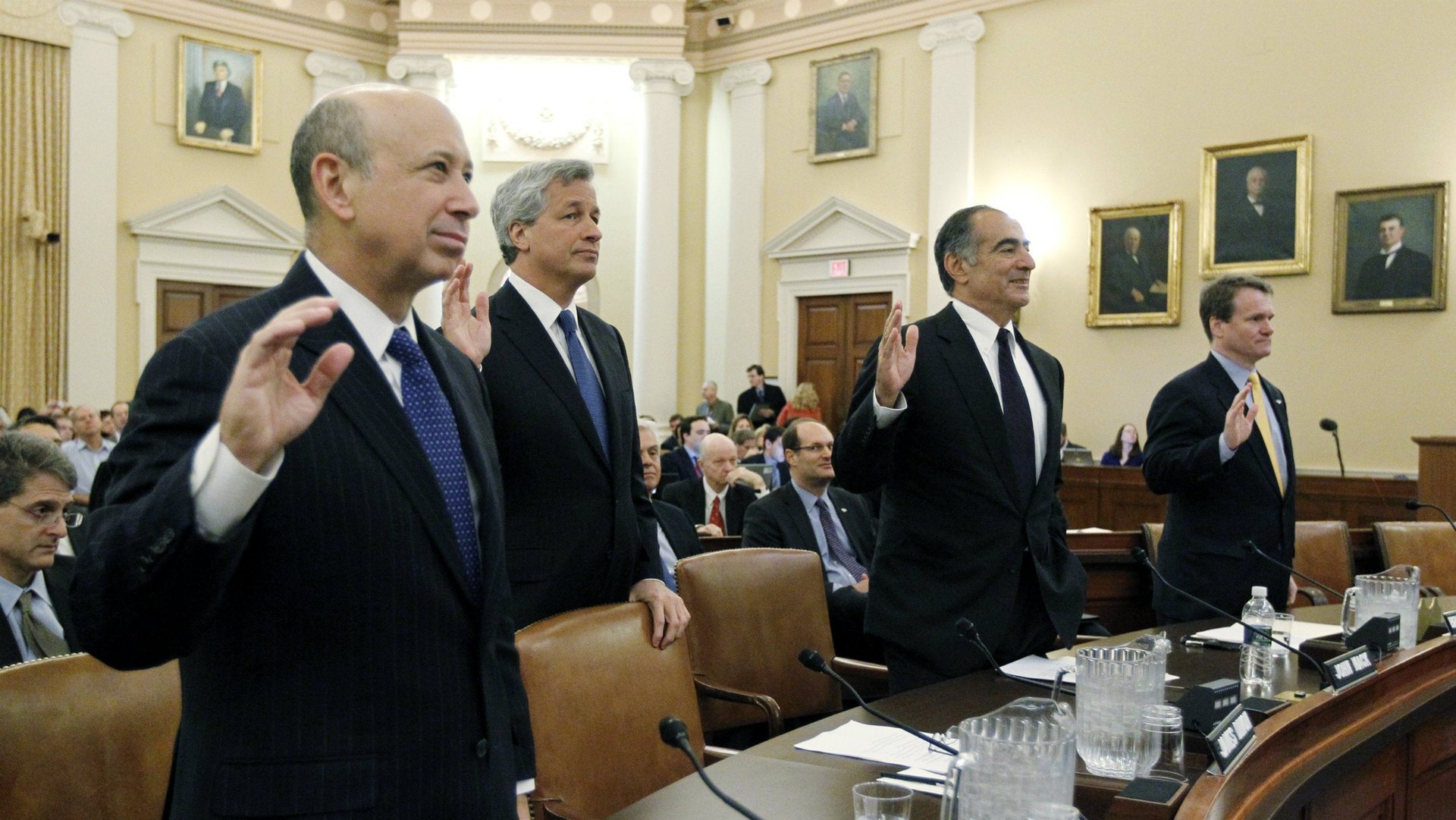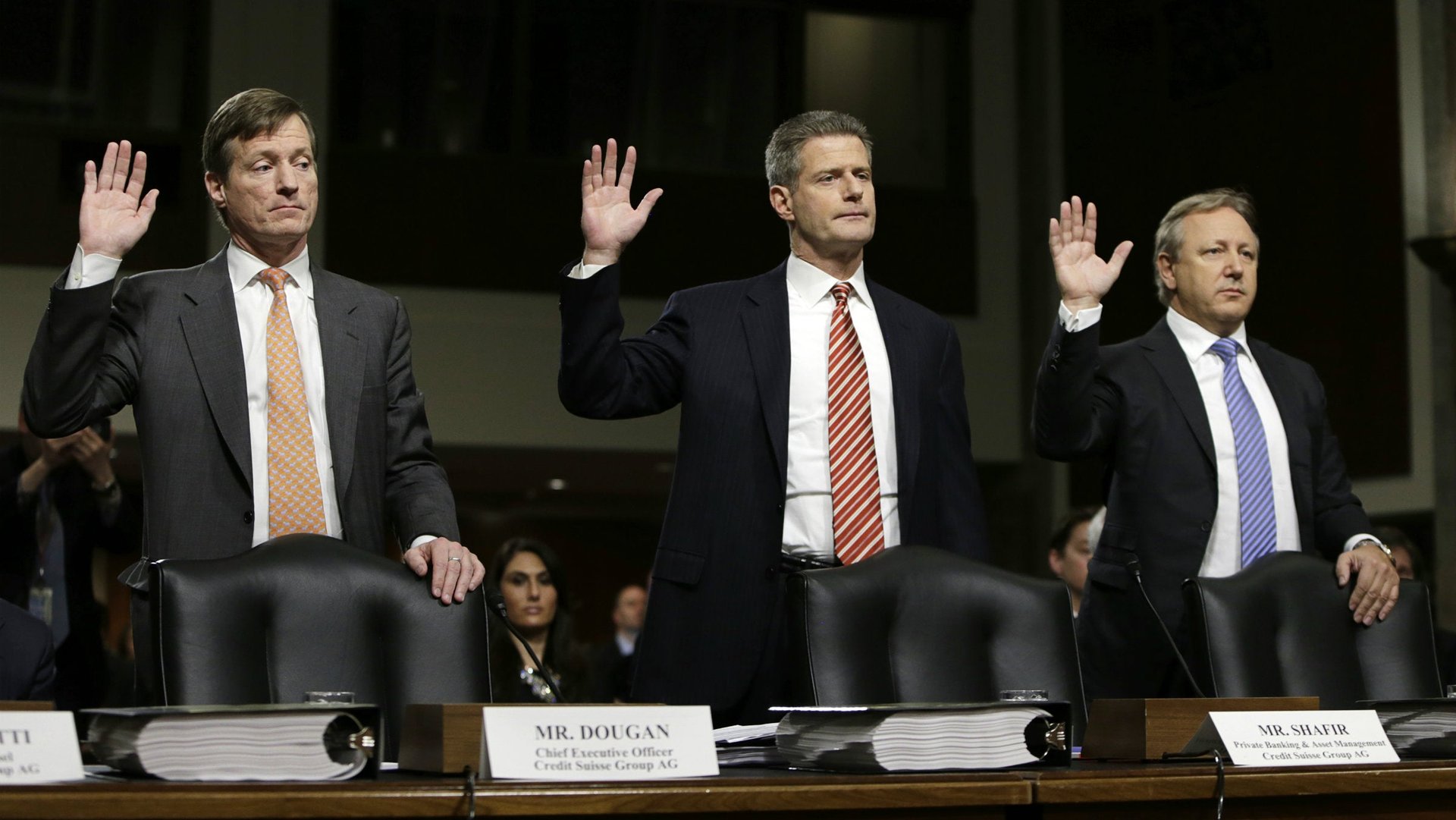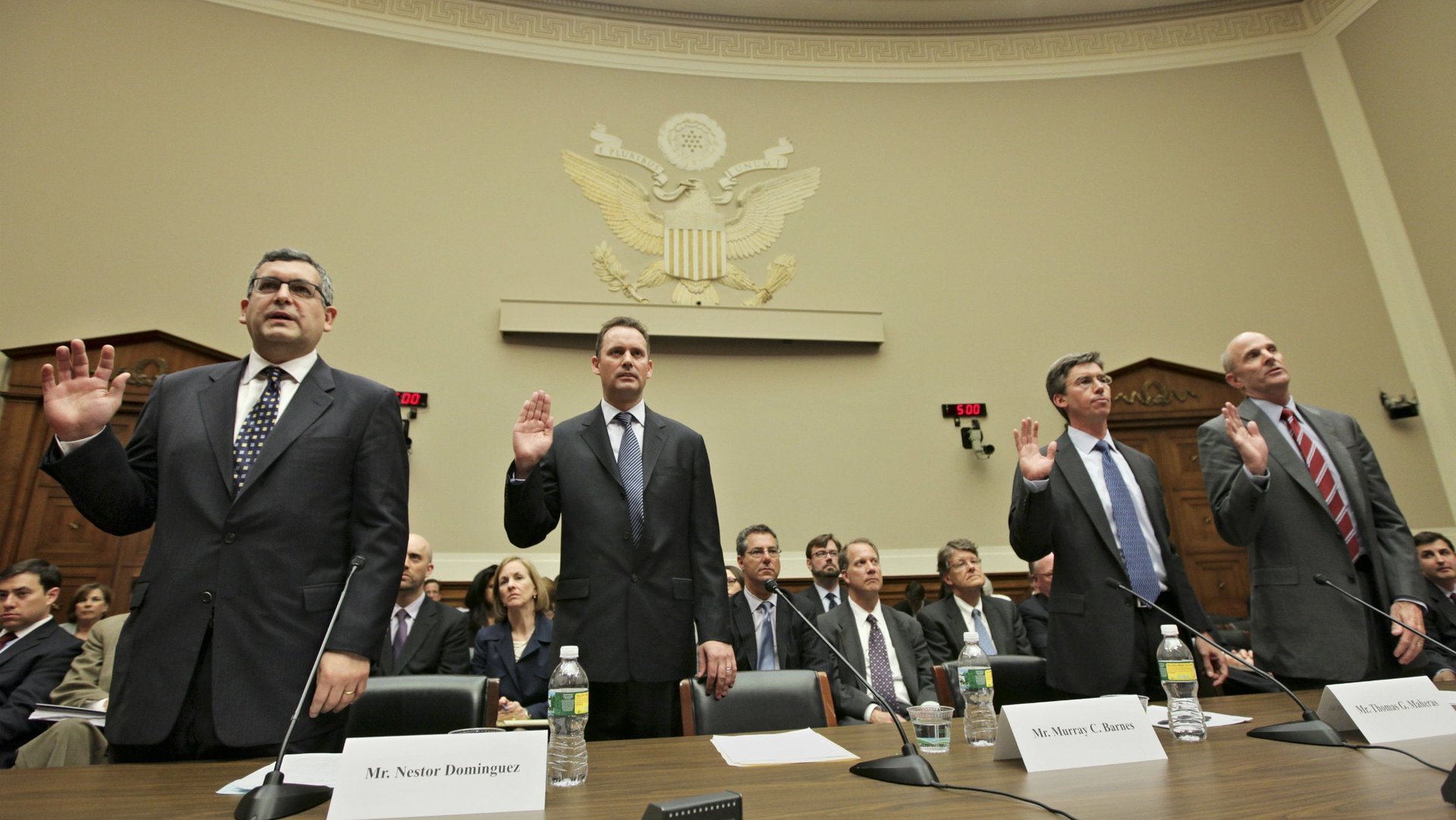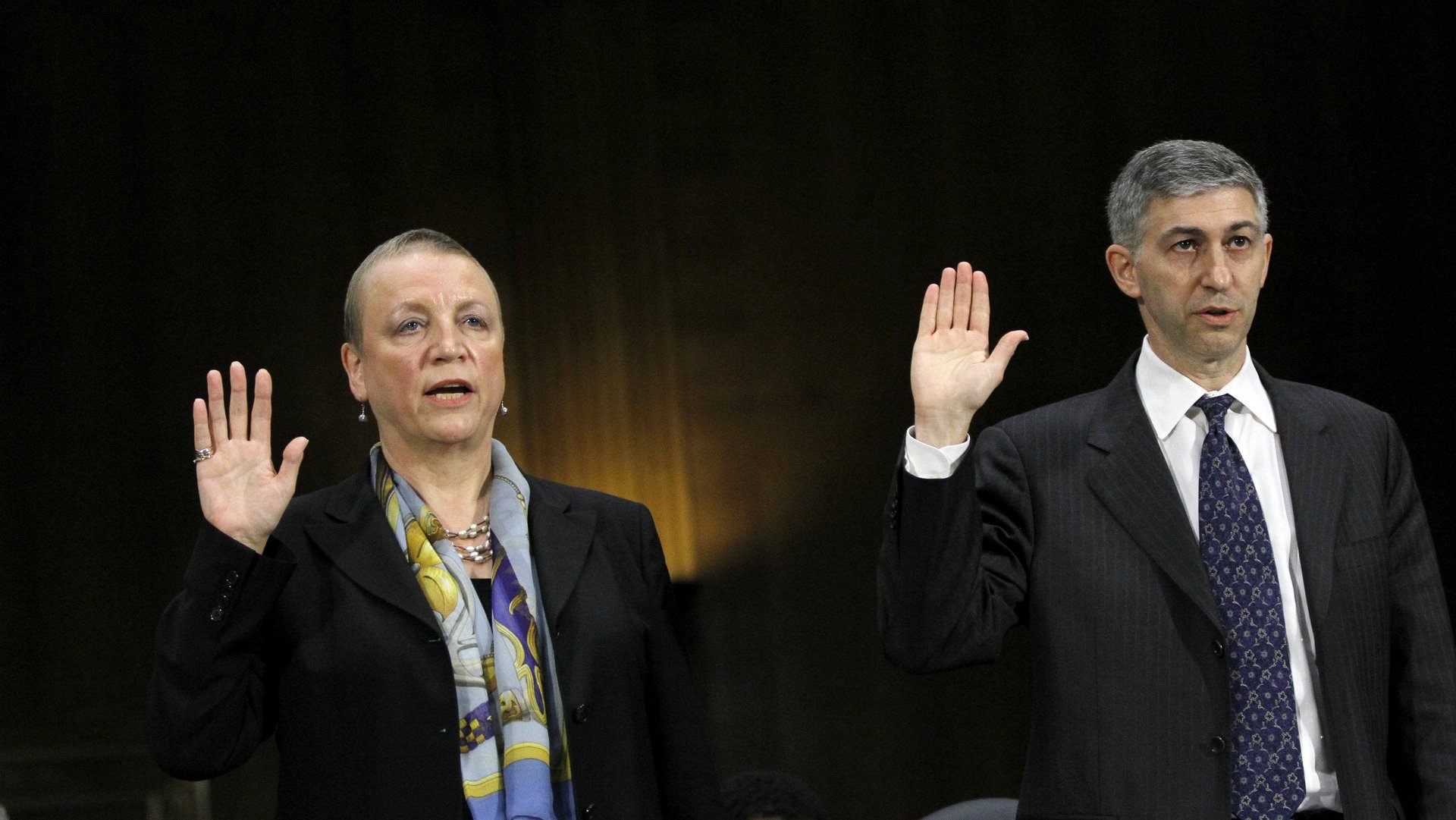That’s it, we can never trust bankers again
Are all bankers liars? Of course not.


Are all bankers liars? Of course not.
Then again…
In an experiment recently published in the scientific journal Nature, bankers distinguished themselves by their dishonesty. Asked to report the results of unsupervised coin flips in return for financial rewards, bankers bent the truth more than any other group. Crucially, this was only after researchers asked the subjects questions about what they did for a living. Thus, bankers who are reminded that they work in banking are more likely to cheat than people in other lines of business.
The researchers were careful not to draw sweeping conclusions from their experiment (pdf), and others have questioned what the study really means. But what is undeniable is that it taps into a prevailing sense that bankers somehow can’t help but behave badly.
This feeling is not new. By the industry’s recent standards, 2014 wasn’t particularly remarkable in terms of bankers breaking the rules. And that’s the problem. The steady stream of scandal at big banks this year may have finally exhausted remaining goodwill that those outside of banking had for people inside of it. This could be the year that any remaining trust was lost.
Or, rather, squandered by an industry predisposed to deceit. No, that’s not fair.
But consider…

Standard Chartered is creating a “Financial Crime Risk Committee,” a board-level group of bigwigs that will monitor the bank’s compliance with “anti-money laundering, sanctions compliance, and prevention of bribery, corruption and tax crime.” All banks have compliance departments, naturally, but few with as big a staff or as much executive clout as Standard Chartered’s.
That’s because the bank’s $667 million settlement in 2012 for breaking US sanctions was just extended for three years pending a new federal probe. New York’s financial watchdog slapped $300 million in additional fines on the bank earlier this year for failing to fix the shortcomings identified in its 2012 settlement.
Time and time again
Standard Chartered isn’t the only repeat offender—last month, Bank of Tokyo-Mitsubishi UFJ paid a $315 million penalty for a cover-up involving a report into sanctions violations that had landed the bank a $250 million fine a year earlier.
Meanwhile, attempts by traders at big banks to manipulate interest-rate benchmarks may have continued even after regulators opened up investigations into alleged rate-rigging. Those probes, which led to settlements worth billions of dollars at a clutch of big lenders, overlapped with similar investigations into the manipulation of foreign-exchange rates, commodity prices, and sundry other markets. And seven years after a huge settlement on research conflicts of interest, bank analysts were back peddling favorable research in hope of securing investment-banking business as if nothing had happened—and as a result 10 banks were just hit with another fine.
Quarter after quarter, big banks seem to spend as much time discussing the details of litigation charges as they do on their core businesses. In fact, it’s become a rather shrewd strategy for banks to snitch on themselves before their competitors can, securing a lesser fine from regulators in return for being the first to fess up.
When will it end? Citigroup recently upped its estimate for looming legal charges for the second time in six weeks. Big banks, including Citi, set aside some $15 billion last quarter for future legal costs. That’s on top of a record-setting $56 billion in legal settlements this year (paywall), the exasperation of regulators evident in ever-larger penalties for persistent wrongdoing. But no fine—however hefty—seems to have much of an effect on bankers’ behavior.
Is banking culture fundamentally rotten? It can’t be.
On the other hand…
While rogue traders have always been a threat to the industry, the preponderance of recent scandals and the fact that few (if any) of the world’s major banks were left untouched suggests there is something broader at work than just a rash of isolated cases or a handful of bad actors.
As the head of the Federal Reserve Bank of New York argued in October—at a Fed workshop on “reforming culture and behavior in the financial services industry”—culture “is how people react not only to black and white, but to all of the shades of grey.” And the financial sector, he asserted, invited a lot more grey into its midst when it created ever more complex products and business structures and shifted emphasis away from traditional retail, commercial, and investment banking (where firms were generally very concerned with client relationships) in favor of trading (where the focus mainly is on transactions).
Add to this a bevy of short-sighted financial incentives and a more fluid market for talent that makes self interest more important than looking out for one’s firm, et voilà: Behavior once considered wrong and rare can quickly work itself into the mainstream.
A British think tank recently said that it will take a generation for big banks to fix their dysfunctional cultures. Board-level committees and a change in the “tone at the top” does not always trickle down to the front lines. Sharp practices of the past are still encouraged, albeit more subtly than before.

Of course, banking is not the only industry where the major players are sometimes, or even often, caught breaking the rules. Like any heavily regulated industry, banks are almost always embroiled in legal trouble of some sort. But what makes the persistent misconduct and toxic culture of modern banks so galling is that, in the words of a former head of Britain’s financial regulator, so much of what they do seems “socially useless.”
There is a growing body of evidence that suggests once the financial industry grows beyond a certain size, it subtracts from a country’s economic growth. Untethered to the economy it is meant to serve, banks devise self-serving, self-referential products and services with massive risks and meager rewards. As one former banker put it, his success was down to “contriving products which were too complicated for clients to evaluate, allowing us to control the pricing.”
Complexity for complexity’s sake
In most industries, innovation is the ideal. But in banking, “innovation” has become a dirty word—shorthand for a dangerous, destructive complexity that bankers can create but are not competent enough to control.
That is the charitable way to frame the big banks’ ongoing turmoil—that they simply don’t know what they’re doing. At least, that’s the impression one gets from the succession of bank CEOs who are called to testify before lawmakers, expressing shock at the misdeeds of their charges and disbelief at the misfortune that has befallen their industry. Banks’ novella-length financial disclosures are now so impenetrable that it can be hard to tell whether they are actually profitable or not.
A more nefarious reading of big banks’ troubles is that they definitely know what they’re doing, and they’re only occasionally acting in the best interests of their clients. Certainly that is the conclusion one might draw from the chat logs (pdf, see footnotes for translation of trader jargon) published by regulators that show traders conspiring to manipulate a wide range of markets, with little concern for the broader financial implications. In a similarly short-sighted way, banks have happily packaged and sold securities comprised of toxic monstrosities to benefit one client to the detriment of others; if the fee is large enough, bankers will even create products that are designed to fail.

No other industry can get away with a similar “buyer beware” attitude—imagine if auto or pharma companies adopted the same indifference to their products. Now imagine that they did it while claiming to do “God’s work,” as Goldman Sachs boss Lloyd Blankfein once said. He took a lot of stick for that statement five years ago; earlier this month, he reportedly complained that banks were as popular as the military during the Vietnam war, a similarly tone-deaf statement.
Credit is a vital component in any healthy economy. But so is power and water, and utility bosses do not appear to harbor the same delusions of grandeur as top bankers—God and war tend not to be the metaphors they reach for to describe their industry’s stature. What’s more, utility execs do not enjoy the same fealty from policymakers nor covet the same privileged position in society. (Their pay and perks also pale in comparison with their banking counterparts.)
Righting the wrongs
Will we ever be able to trust bankers again? Probably not.
But it doesn’t matter…
If we can’t trust them, the best we can do is contain them—in essence, to limit the damage that banks can do if, or when, they run aground. That calls for simple, blunt rules. If banks want to dabble in “financial weapons of mass destruction,” as Warren Buffett once described certain complex securities, then their internal defenses should be strong enough to contain any collateral damage.
Hiking up capital requirements is the most effective tool in this regard—the bigger a bank’s buffers, the better that the economy at large is shielded from its inevitable blunders. It’s best to set these standards using simple, transparent measures like total equity and assets. Ideally, capital requirements should be finely tuned according to individual banks’ tier-one capital and risk-weighted assets, but as should be clear by now, we can’t trust big banks to give a truthful account of the quality of the capital and the severity of the risks lurking on their balance sheets.
In November, RBS found an accounting error that cut more than $4 billion from the tier-one capital it reported to EU regulators. JPMorgan often boasts about its “fortress balance sheet,” but the Fed recently said that its capital level falls $22 billion short of the new minimum that will be rolled out over the next few years—the only big bank to face a shortfall.
The banking industry’s vehement opposition to leverage limits—a simple cap on the amount of equity a bank must maintain for a given amount of liabilities—should be taken as a sign that these restrictions are a step in the right direction. The industry’s fear of the global regulatory community’s new concept of “total loss-absorbing capital”—a banker described it as a “really scary number”—is another encouraging sign.
No businesses deserve capricious regulation, but some are less undeserving than others. The scale of the deficit in trust between banks and society justifies aggressive, intrusive, and costly new restrictions in 2015 and beyond. Most bankers probably aren’t liars, but they no longer deserve the benefit of the doubt.